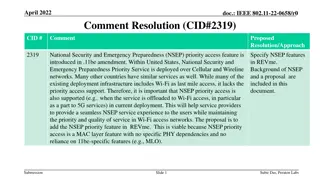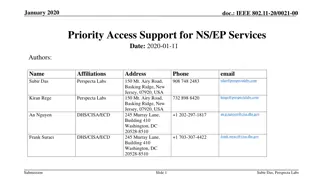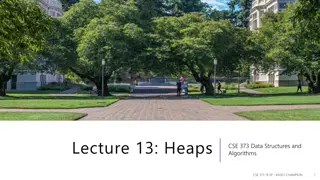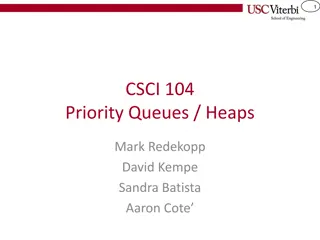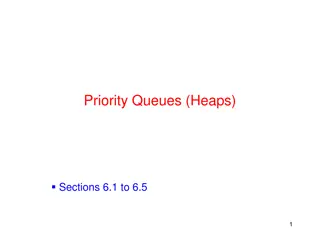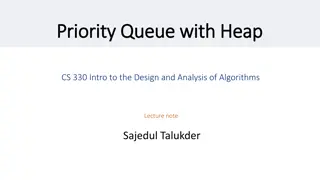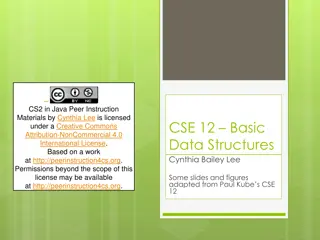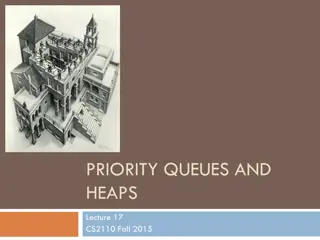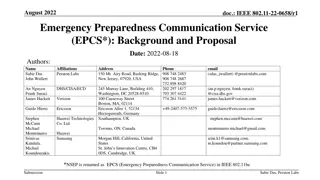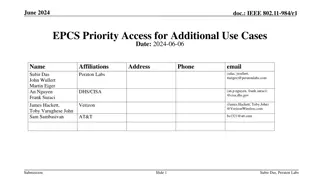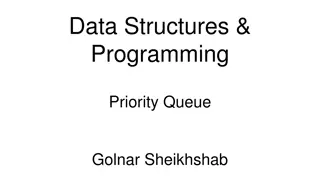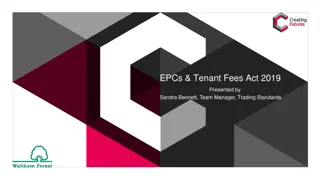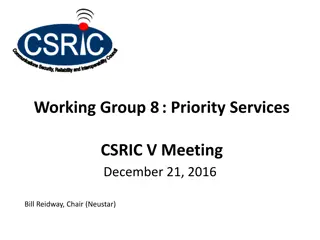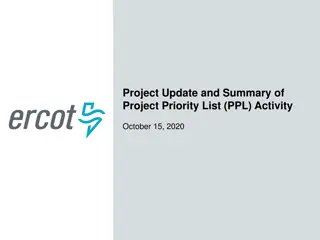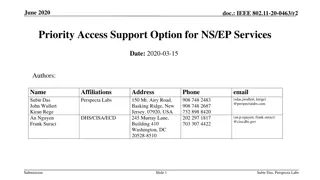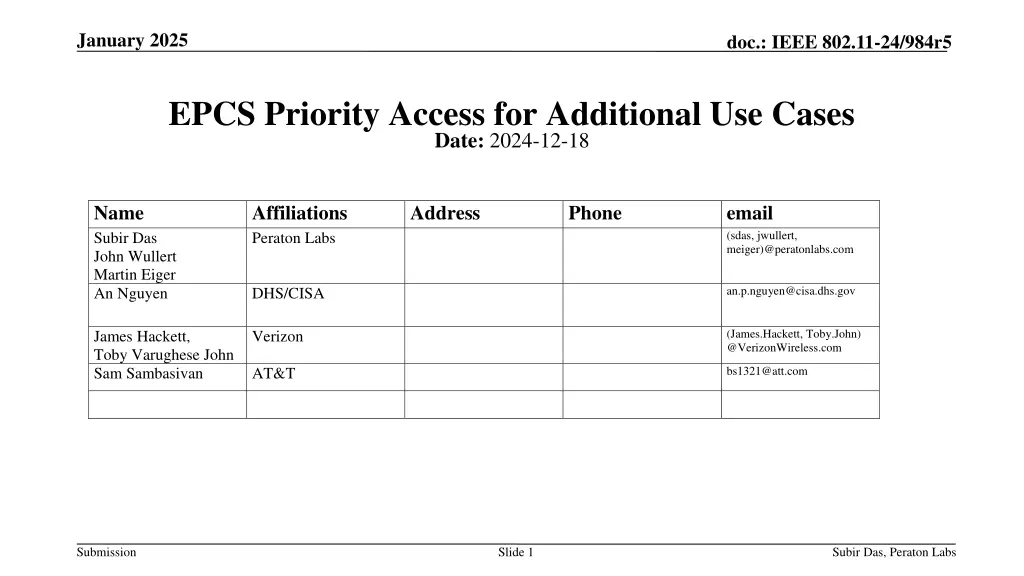
EPCS Priority Access in IEEE 802.11-24/984r5
Explore the need for Emergency Preparedness Communications Service (EPCS) Priority Access in IEEE 802.11 to support critical use cases during emergencies. Learn about the requirements and use cases for enabling priority access for authorized users to ensure effective communication during crisis situations.
Download Presentation

Please find below an Image/Link to download the presentation.
The content on the website is provided AS IS for your information and personal use only. It may not be sold, licensed, or shared on other websites without obtaining consent from the author. If you encounter any issues during the download, it is possible that the publisher has removed the file from their server.
You are allowed to download the files provided on this website for personal or commercial use, subject to the condition that they are used lawfully. All files are the property of their respective owners.
The content on the website is provided AS IS for your information and personal use only. It may not be sold, licensed, or shared on other websites without obtaining consent from the author.
E N D
Presentation Transcript
January 2025 doc.: IEEE 802.11-24/984r5 EPCS Priority Access for Additional Use Cases Date: 2024-12-18 Name Subir Das John Wullert Martin Eiger An Nguyen Affiliations Peraton Labs Address Phone email (sdas, jwullert, meiger)@peratonlabs.com an.p.nguyen@cisa.dhs.gov DHS/CISA (James.Hackett, Toby.John) @VerizonWireless.com James Hackett, Toby Varughese John Sam Sambasivan Verizon bs1321@att.com AT&T Submission Slide 1 Subir Das, Peraton Labs
January 2025 doc.: IEEE 802.11-24/984r5 Abstract This presentation discusses the need for EPCS Priority Access to support additional use cases Submission Slide 2 Subir Das, Peraton Labs
January 2025 doc.: IEEE 802.11-24/984r5 Background EPCS (Emergency Preparedness Communications Service) Priority Access features were specified in IEEE 802.11be for supporting National Security and Emergency Preparedness (NSEP) Communications The use case required non-AP MLD to be successfully authenticated and associated with an AP MLD before EPCS Priority Access can be enabled AP MLD can grant the EPCS Priority Access once it verifies that non-AP MLD has the authority to use the features Either non-AP MLD or AP MLD can request and tear down the EPCS Priority Access This feature is optional in IEEE 802.11be Submission Slide 3 Subir Das, Peraton Labs
January 2025 doc.: IEEE 802.11-24/984r5 Use Case I and Requirements During emergencies, network congestion may prevent users with emergency preparedness responsibilities from (re)associating. Enabling their access requires that STAs capable of obtaining EPCS Priority Access (i.e., those configured to be authorized for the service) should be able to transmit management frames for authentication and association with higher priority than normal STAs Failure to support the above will prevent EP personnel, whose mission is to help the citizens during emergencies and save lives, from performing their responsibilities The current solution in IEEE 802.11be does not support the above use case The scope in IEEE 802.11be was limited and it was appropriate at that time Given the market acceptance of the EPCS features, it is essential that we address this use case in IEEE 802.11bn Submission Slide 4 Subir Das, Peraton Labs
January 2025 doc.: IEEE 802.11-24/984r5 Use Case II and Requirements Use Case II: During crisis situation, WLAN may become congested with traffic from general public and users authorized for priority at several levels. To ensure authorized EPCS users can communicate to fulfill their emergency responsibilities, network may need to restrict access. Such restrictions could apply to public users with an exemption for EPCS users to ensure their ability to communicate. Form of Preemption: process of terminating (or degrading) lower priority communications in favor of higher priority communications Our aim is to provide mechanism that gives benefits of preemption, as defined, through controlled management of channel access IEEE 802.11 networks should provide means to enable access control with an exemption on behalf of EPCS STAs Current EPCS priority in IEEE 802.11be only provides probabilistic advantage via EDCA Controlled access could provide critical advantage for NS/EP personnel under extreme conditions Given the new regulatory and existing service requirements, it is important that we address the above in IEEE 802.11bn Submission Slide 5 Subir Das, Peraton Labs
January 2025 doc.: IEEE 802.11-24/984r5 Regulatory Update in USA Federal Communication Commission (FCC) within United States released a new Report and Order (FCC-22-36) addressing the Wireless Priority Service (WPS) (a.k.a., NSEP Priority Service) in 2022 Report and Order (R&O) specifies operation of priority service on public wireless communications networks A few highlights on Wireless Priority Service (WPS) Explicitly authorizes WPS preemption of public communications Preemption: process of terminating or degrading lower priority communications in favor of higher priority communications Expressly permits priority voice, video, and data sessions Expressly authorizes priority signaling (registration, invocation) Expands WPS eligibility to include additional users Clarifies that higher priority users take precedence over those with lower priority Five (5) priority levels were defined in earlier R & O Note: Wireless Priority Service (WPS) is not mandated by the FCC Submission Slide 6 Subir Das, Peraton Labs
January 2025 doc.: IEEE 802.11-24/984r5 3GPP Cellular Network Approach to Support Use Cases Cellular networks support concept of Access Class Barring Every station is assigned one of ten base access classes Select stations are also assigned one of a small set of elevated access classes e.g., access classes for network management, those making emergency (e.g., 911, 112) calls When network load increases, Base Station can (probabilistically) bar some classes from gaining access Base station broadcasts barring factors for ten base access classes User devices generate random number only those with number less than barring factor are allowed attempt network access Select stations with an elevated access class are exempt from access class barring test NS/EP users have dedicated access class that gives them exemption from access class barring This is analogy with desirable characteristics. Implementation within WLAN is TBD. Submission Slide 7 Subir Das, Peraton Labs
January 2025 doc.: IEEE 802.11-24/984r5 Example Priority Services Offered in Various Countries In Belgium, Blue Light Mobile service enables priority communications for users with national security and emergency preparedness responsibilities Priority involves both exemption network management controls for both lower- and higher-priority users and preemption of other traffic on behalf of higher-priority users In Czech Republic, mobile crises communications service provides priority for three user classes and four priority levels Traffic assigned to priority levels based on user class and situation (e.g., crisis or non-crisis) Service includes variety of priority actions, e.g., calls at highest priority level can preempt lower- priority and non-priority calls other than emergency (i.e., 112) calls. In Denmark, priority communications program provides preferential network access for first responders and individuals supporting critical infrastructure Supports two priority levels, one that includes preferential access by authorized users and another that, when declared, restricts network access by (i.e., preempts) non-priority users Submission Slide 8 Subir Das, Peraton Labs
January 2025 doc.: IEEE 802.11-24/984r5 What is problem during Pre-Association? During high network overload situations, our simulation shows that all STAs suffer when attempting to send an Association Request (AR) (using AC_VO) while with a small change in EDCA parameters results in successful transmission Blue circles show adverse impact of competing traffic on transmission of a single Association Request frame with no priority (even with 10 retries) Orange squares show benefit with small change in EDCA parameters resulting in advantage for small number of users sending association requests (10 retries) Discrete event MAC-layer simulation For each run, total traffic generating stations broken down as: 41.7% voice, 16.6% video, 41.7% best effort, plus 20 stations sending association request Channel Bandwidth: 20 Mhz EDCA Parameters (AIFSN, CWmin-CWmax) Default: AC_VO: 2, 3-7; AC_VI: 2, 7-15; AC_BE: 3, 15-1023 Degraded: AC_VO: 4, 7-15; AC_VI: 4, 15-31; AC_BE: 5, 31-1023 AR transmitted using corresponding AC_VO parameters Submission Slide 9 Subir Das, Peraton Labs
January 2025 doc.: IEEE 802.11-24/984r5 Pre-Association EPCS Priority Candidate Approaches Send advantaged EDCA parameters for unassociated non-AP MLDs that have EPCS active Using Beacon Frame Using a dedicated Public Action Frame (TBD) Allocate resources to STAs affiliated with unassociated non-AP MLDs that have EPCS active Using TUA (Ref: IEEE 802.11REVme D7.0 Clauses 10.2.5, 26.5.2, 26.5.4) Note: EPCS Active state needs to be specified with a MIB variable. Non-AP MLDs provisioned to use EPCS would have this variable set (e.g. EPCSActivated) MIB variable is set via a provisioning interface by a service provider or other responsible entity on devices for which AAA server is also being provisioned to authorize EPCS Concept used in existing features that have Implemented and Activated states defined as MIB variables (e.g., QoSMap, SSPNInterface) Slide 10 Submission Subir Das, Peraton Labs
January 2025 doc.: IEEE 802.11-24/984r5 Advantaged EDCA using Beacon Frame Add optional multi-link element that carries EDCA parameters to be used by STAs affiliated with unassociated non-AP MLDs with EPCS activated AP broadcasts normal EDCA and advantaged EDCA parameters Advantaged EDCA parameters to be used by STAs affiliated with unassociated non-AP MLDs and normal EDCA parameters to be used by non-EPCA STAs Advantaged EDCA parameters do not need to be carried in every Beacon frame (e.g., send in every third or fourth beacon) Send only when conditions warrant (e.g., AP senses severe overload conditions, AP is triggered by external source) Advantaged EDCA does not need to be full multi-link element or full set of EDCA parameters Only include AC_VO parameter, which is used for management frames Pros: Reuses existing Beacon frame and processing logic Allows AP MLD to control pre-association priority by whether frame is sent Allows AP MLD to manage priority using EDCA parameter values Cons: Beacon bloating Submission Slide 11 Subir Das, Peraton Labs
January 2025 doc.: IEEE 802.11-24/984r5 Advantaged EDCA Using Public Action Frame Specify a public action frame to send advantaged EDCA parameters to be used by STAs affiliated with unassociated non-AP MLDs with EPCS activated Addressing options Broadcast: AP MLD sends frame like a Beacon All .11bn STAs interpret frame after reception; those without EPCS activated take no action Multicast: AP MLD sends frame to multicast AID for unassociated STAs All unassociated .11bn STAs interpret frame after reception; those without EPCS activated take no action Pros Avoids Beacon bloating with additional EDCA parameters Allows AP MLD to control pre-association priority by whether frame is sent and how often Allows AP MLD to manage priority using EDCA parameter values Cons Need to specify a new frame Submission Slide 12 Subir Das, Peraton Labs
January 2025 doc.: IEEE 802.11-24/984r5 Using Triggered Uplink Access Build on existing TUA that provides means for AP to allocate resources to unassociated STAs using a dedicated AID Define AID to address STAs affiliated with unassociated non-AP MLDs with EPCS activated AP periodically allocates resources to STAs affiliated with unassociated non-AP MLDs with EPCS activated by sending a Trigger frame to the dedicated AID Send only when conditions warrant (e.g., AP senses overload conditions, AP is triggered by external source) Those STAs compete among themselves for the allocated resources Pros AP has complete control of whether to allocate resources and how much to allocate Builds on existing capability for allocating resources to unassociated STAs (via AID 2045) (See Clause 26.11 in REVme specification) Cons Requires TUA to be supported Submission Slide 13 Subir Das, Peraton Labs
January 2025 doc.: IEEE 802.11-24/984r5 Discussion Perceived Problem Without prior authorization, rogue STAs without EPCS activated could use the advantaged EDCA parameters or the allocated TUA resources Response: Any station that wants to ignore specification can do so, independent of this feature AP MLD can determine if STAs are EPCS authorized (after a limited number of exchanges) and take appropriate action Note 1: Definition of RADIUS attributes for EPCS authorization is in progress in IETF and WBA Note 2: EPCS is specified to be used by authorized stations on managed networks, where service provider can set their policies Submission Slide 14 Subir Das, Peraton Labs
January 2025 doc.: IEEE 802.11-24/984r5 Straw Poll -1 SP1: Do you agree to include the following in TGbn SFD: Define an optional mechanism that enables priority channel access for non-AP STAs affiliated with non-AP MLDs that have EPCS activated for transmission of management frames prior to Robust Security Network Association (RSNA) if applicable otherwise prior to (Re)Association with the AP MLD? Notes: 1. The AP MLD can control whether any non-AP MLDs with EPCS activated are allowed to use the feature (e.g., enabling it when triggered to do so by an external entity in response to an emergency declaration) 2. The mechanism is TBD 3. Whether and/or how the mechanism is applied during each of the phases of the (re)association process is TBD 4. EPCS activated indicates non-AP MLDs that have been provisioned to use EPCS by a responsible external entity Y N - A - Submission Slide 15 Subir Das, Peraton Labs
January 2025 doc.: IEEE 802.11-984/r4 Straw Poll -2 SP2: Do you agree to include the following in TGbn SFD: Define an optional mechanism that enables AP MLD to terminate or degrade lower priority communications in favor of higher priority communications. Note: STAs whose communications are terminated or degraded could include non-EPCS and lower priority EPCS STAs Note: Per use case requirement 2 and FCC Report and Order 22-36 Y N - A - Submission Slide 16 Subir Das, Peraton Labs
January 2025 doc.: IEEE 802.11-24/984r5 References IEEE 802.11be Draft 7.0: https://www.ieee802.org/11/private/Draft_Standards/11be/Draft%20P802.11be_D7.0.pdf FCC Review of Rules and Requirements For Priority Services, FCC-22-36, https://www.fcc.gov/document/fcc-modernizes-and- improves-its-priority-services-rules-0 https://mentor.ieee.org/802.11/dcn/22/11-22-1074-01-0wng-priority-access-fcc-r-o-and-additional-use-cases.pdf Information on the Belgium Blue Light Mobile service was found in the following sources (Last viewed May 2024): https://www.astrid.be/en/services/blue-light-mobile, (in English), https://www.astrid.be/sites/public/files/2024- 02/BLM_userguide_jan2024_NL.pdf (in Dutch), https://www.criticalcomms.com/content/news/belgium-astrid-launches-the-next- generation-of-its-blue-light-mobile-service (in English), https://www.criticalcomms.com/content/news/belgium-astrid-launches- the-next-generation-of-its-blue-light-mobile-service (in English) Information on the mobile crisis communications services within the Czech Republic was found in the following sources (Last viewed: May 2024): http://www.hzscr.cz/soubor/04-krizova-komunikace-rezim-kompatibility-pdf.aspx (in Czech) and Communication of the Integrated Rescue System (netstranky.cz) (in Czech). Information on the mobile crisis communications services within Denmark was found in the following sources (Last viewed: May 2024): Beskrivelse af mobilprioriteringsordningen__CFCS_juli 2019 (in Danish) and vejledning-til-prioriteringsordningen-i-4g- netvark.pdf (cfcs.dk) (in Danish) Description of access class barring: Performance analysis of access class barring for next generation IoT devices - ScienceDirect 18 - Submission Slide 17 Subir Das, Peraton Labs
January 2025 doc.: IEEE 802.11-24/984r5 BACKUP Collisions between Priority Traffic 20 Stations Sending EPCS Association Requests 100% 10 Stations Sending EPCS Association Requests 100% Default EDCA (EPCS AR) + degraded EDCA (other) Degraded EDCA (all) Transmission Success Rate Transmission Success Rate 80% 80% Association Request Association Request Default EDCA (EPCS AR) + degraded EDCA (other) Degraded EDCA (all) 60% Default EDCA (all) 60% Default EDCA (all) 40% 40% 20% 20% 0% 0% 5 20 35 50 65 80 95 110 125 5 20 35 50 65 80 95 110 125 Number of Traffic-Generating Stations Number of Traffic-Generating Stations Submission Slide 18 Subir Das, Peraton Labs

